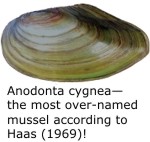| Page last updated
28 December 2007 |
Certain Mussel Species Have been Over-Named
 One of the challenges of trying to understand the species diversity of a taxon like the Unionoida is trying to determine what the species actually are. Freshwater mussels tend to have large ranges and are often habitat generalists. In fact, lotic (or river-dwelling) mussels live in a one-dimensional, unidirectional habitat gradient— a river, flowing only downstream, evolves over its course from the turbulent, small-stream conditions of its headwaters to the more static, lamellar flow of its big-river environment. The expectation would be that the string of populations living along this cline would be adapted to their local environment, either genetically or ecophenotypically. For freshwater mussels, this phenomenon is known as Ortmann's Law of Stream Position (Ortmann, 1920). Such extreme within-species variation, as well as antiquated species definitions, led many works to over-name freshwater mussels. That is, they gave single species multiple names thinking that they were several species. This practice is known as splitting. All the mussel names that refer to the same species are known as synonyms. One of the challenges of trying to understand the species diversity of a taxon like the Unionoida is trying to determine what the species actually are. Freshwater mussels tend to have large ranges and are often habitat generalists. In fact, lotic (or river-dwelling) mussels live in a one-dimensional, unidirectional habitat gradient— a river, flowing only downstream, evolves over its course from the turbulent, small-stream conditions of its headwaters to the more static, lamellar flow of its big-river environment. The expectation would be that the string of populations living along this cline would be adapted to their local environment, either genetically or ecophenotypically. For freshwater mussels, this phenomenon is known as Ortmann's Law of Stream Position (Ortmann, 1920). Such extreme within-species variation, as well as antiquated species definitions, led many works to over-name freshwater mussels. That is, they gave single species multiple names thinking that they were several species. This practice is known as splitting. All the mussel names that refer to the same species are known as synonyms.
| 9 Most Over-Names Species |
Geography |
Synonyms |
| Anodonta cygnea |
Palearctic |
549 |
| Unio crassus |
Palearctic |
225 |
| Unio elongatulus |
Palearctic |
179 |
| Unio pictorum |
Palearctic |
125 |
| Elliptio violaceus [=complanata] |
Nearctic |
99 |
| Potomida [= Psilunio] littoralis |
Palearctic |
78 |
| Anodonta [= Sinanodonta] woodiana |
Oriental |
67 |
| Unio tigridis |
Palearctic |
44 |
| Unio tumidus |
Palearctic |
56 |
| Total |
|
1422 |
| According to Haas (1969), 4178 names have been applied to 837 species. Thus, these nine over-named species account for over 1/3 of all available names! |
|
The data in the table above are from Haas (1969), the last comprehensive treatment of freshwater mussel species. From Haas's synonymies, we find that the average synonymy rate is about 5:1. That is, enough names have been applied to freshwater mussels (nearly 4180!) for each of the 837 species he recognized to have been named five times. Of course, it is also evident from Haas's data that these extra names are not randomly distributed across the species of the Unionoida; rather certain species have been over-named beyond others. The most extreme examples, according to Haas, are listed in the table.
The perfect receipe for an over-named species seems to be a mussel that is widespread across mutliple human population centers where universities and taxonomists are concentrated. Seven of the species listed in the table are from western Europe, one (Elliptio complanata) is from the Atlantic Slope of the North America, and the last (Sinanodonta woodiana) is a widespread species from eastern Asia. The "winner" by far is Anodonta cygnea, with 549 names (fide Haas, 1969). This mussel ranges widely across the Palearctic region and occurs in a variety of habitats.
While many freshwater mussel names were introduced, as the previous paragraph suggests, by wide-ranging species coming to the attention of numerous, isolated taxonomists, one should not overlook the contributions of a few mussel workers that simply liked to introduce new names for minor morphological variants. The king of those was a Philadelphian named Isaac Lea.
References
- Ortmann, A.E. 1920. Correlation of shape and station in freshwater mussels (Naiades). Proceedings of the American Philosophical Society 19: 269-312.
- Haas, F. 1969. Superfamilia Unionacea. Das Tierreich (Berlin) 88. 663 pp.
|